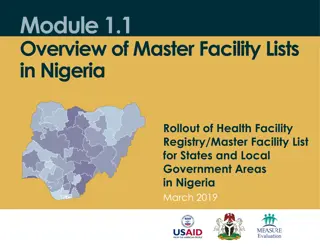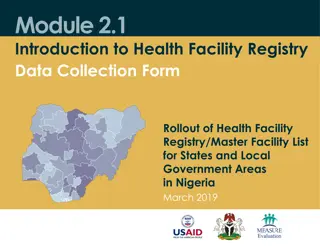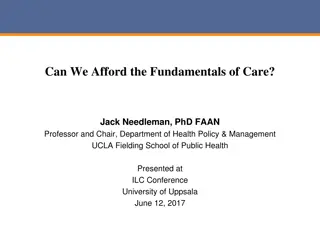The Impact of Reduced Skilled Nursing Facility Length of Stay
Research explores the consequences of Medicare policy changes leading to shorter post-acute care stays in skilled nursing facilities. Findings highlight challenges faced by providers, unintended outcomes for patients, and responses by SNFs. Insights reveal the complexities and implications of reduced SNF length of stay on patient care and facility operations.
Download Presentation

Please find below an Image/Link to download the presentation.
The content on the website is provided AS IS for your information and personal use only. It may not be sold, licensed, or shared on other websites without obtaining consent from the author.If you encounter any issues during the download, it is possible that the publisher has removed the file from their server.
You are allowed to download the files provided on this website for personal or commercial use, subject to the condition that they are used lawfully. All files are the property of their respective owners.
The content on the website is provided AS IS for your information and personal use only. It may not be sold, licensed, or shared on other websites without obtaining consent from the author.
E N D
Presentation Transcript
The Unintended Consequences of Reduced Skilled Nursing Facility Length of Stay Denise A. Tyler, John McHugh, Renee R. Shield, Ulrika Winblad, Emily A. Gadbois Presented by Emily A. Gadbois
Acknowledgments NIA Program Project (Grant #AG-027296)
Background In the US, patients covered by Medicare often require post-acute care (PAC) after a hospitalization This care is commonly provided in skilled nursing facilities (SNFs) In recent years, Medicare policy changes and market-based pressures have resulted in reductions in median PAC length of stay in SNFs Little research examining associated impacts
Research Objective To identify : the key challenges that reductions in SNF length of stay (LOS) pose for PAC providers the unintended consequences of reduced LOS for PAC providers and patients SNF responses to these
Methods Conducted site visits to 8 markets in the U.S. In each market: one hospital with a low readmission rate and one with a higher rate, 3 or 4 SNFs that received referrals from those hospitals Interviewed ~20 staff from the selected organizations in each market, yielding 154 interviews in 16 hospitals and 24 SNFs
Methods Examined median LOS for the 24 SNFs we visited to identify SNFs with LOS reductions between 2012 and 2014, and those without LOS reductions Data from interviews with staff in SNFs with no LOS reduction were compared and contrasted with data from interviews with staff in SNFs with LOS reductions
Results: Overview Among SNFs with LOS reductions: No time to help patients find appropriate long term care; had to discharge patients who they felt were unsafe Some developed programs to follow-up with patients post-discharge Some avoided admitting patients with potential to become long-stay Among SNFs with no LOS reductions: Fear of losing relationships with referring hospitals if they surpass pre-determined length Patients becoming unexpectedly responsible for costs
Results: SNFs with Reductions in LOS No time to help patients find appropriate long term care; had to discharge patients who they felt were unsafe I came in and I m like guys, guess what? You gotta discharge these people! ...I m like get em out guys! Get em out! Get emout! And I feel terrible, it s awful because you know that they deserve more therapy, they have that benefit. (SNF Administrator)
Results: SNFs with Reductions in LOS No time to help patients find appropriate long term care; had to discharge patients who they felt were unsafe There're times that I feel that there's such a rush. Yaknow, people are very sick. And having that sort of expectation put on them, say you're only in a SNF for ten days, to me it's a challenge...A big reward for me is to see the person go home well. But telling an eighty-five year old that I'm sorry, your insurance is only authorizing you to stay for two weeks, then they have to appeal... (SNF Director of Nursing)
Results: SNFs with Reductions in LOS Some developed programs to follow-up with patients post-discharge Then, we have the care transition coach that follows them outside when they discharge from us...They call them, talk to them, go visit with them, make sure they re getting to their doctor s appointments, if they need help making doctor s appointments or getting transportation, what are the barriers to taking care of their health at home, to prevent hospitalization. (SNF Admissions Director)
Results: SNFs with Reductions in LOS Some developed programs to follow-up with patients post-discharge So our discharge planner does two day, fourteen day, thirty day, and then sixty day follow-ups with that patient to make sure they are taking their medication, to see if they have questions and to see how they're doing. (SNF Administrator)
Results: SNFs with Reductions in LOS Some avoided admitting patients with potential to become long-stay One issue that we all have problems with, and I know we re not isolated, is when... that patient is going to possibly run out of their SNF days, and not have family support, [and] have a lot of comorbidities. When there s a placement issue, a lot of times the SNFs are trying to be more creative with the residential facilities on how they can solve that issue. Whereas before, it still was a hospital, acute care problem. (Hospital VP of Care Coordination)
Results: SNFs with Reductions in LOS Some avoided admitting patients with potential to become long-stay So I do the screen and...I have to factor in what kind of insurance does she have, how many benefit days does she have, then I might request an application which requests a financial disclosure so in the event that that person doesn't leave or isn't able to go back to their living environment we have to find a living environment for them and we need to know if they can afford what they really think they want. (SNF Admissions Director)
Results: SNFs with No Reductions in LOS Fear of losing relationships with referring hospitals Sometimes it make us, [sighs] not very comfortable, but then you need to work with them, too, you know? It s a situation that you don t feel like you want to lose your connection with them and you want to make sure that you reach the goal, the expectation, so all we gottado is just speed up and do things. (SNF Administrator)
Results: SNFs with No Reductions in LOS Fear of losing relationships with referring hospitals You re getting reprimanded, for sure, and you know, you don t like to destroy the relationship that you have with them, because you might end up getting less patients [chuckle], and that s the thing we re trying to avoid. There s no written in stone policy what your consequences would be, but, obviously, you re gonnaget more patients if you follow them. (SNF Admissions Director)
Results: SNFs with No Reductions in LOS Patients becoming unexpectedly responsible for costs For a craniotomy you have between 12 and 17 days... So if you re gonna hit over 17 they re gonna say okay, well then discharge them. Well, it s not safe. Well then, they can t go home, they just have to pay privately. (SNF Administrator)
Results: SNFs with No Reductions in LOS Patients becoming unexpectedly responsible for costs If the resident doesn't have co-insurance then they will be responsible for the additional cost which averages out to be about $157 per day... Upon admission we will notify the resident if they don't have co-insurance and they need therapy or they want to stay longer that there may be a payment that they're going to have to be responsible for. (SNF Administrator)
Results: SNFs with No Reductions in LOS Patients becoming unexpectedly responsible for costs The resident has the right to appeal and we'll assist with that. Sometimes the appeals do go through and most of the time they don't. (SNF Administrator)
Conclusions SNFs have seen a reduction in median LOS The push for shorter SNF LOS has resulted in challenges for SNFs and possible unintended consequences for patients, including increased costs for care and potentially unsafe discharges. Patients may also have difficulty finding facilities willing to accept them if they may eventually need long-term care
Implications for Policy and Practice Additional research needed to determine if the challenges and unintended consequences identified by our exploratory research are widespread Policymakers must ensure patients receive the care they need, are not left responsible for unexpected costs, and are not discharged unsafely or to a location that cannot provide the long-term care they may need
Thank You emily_gadbois@brown.edu























